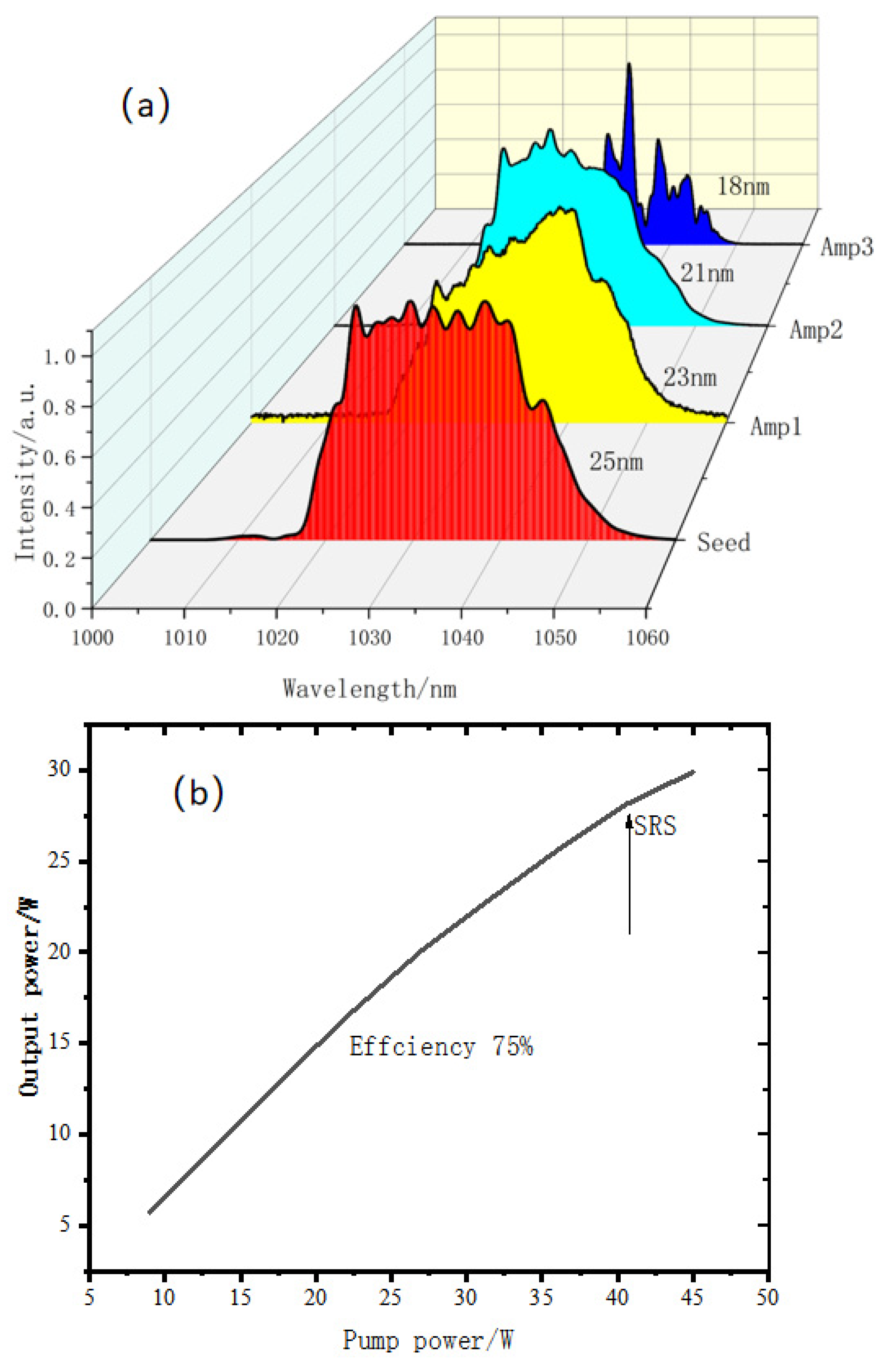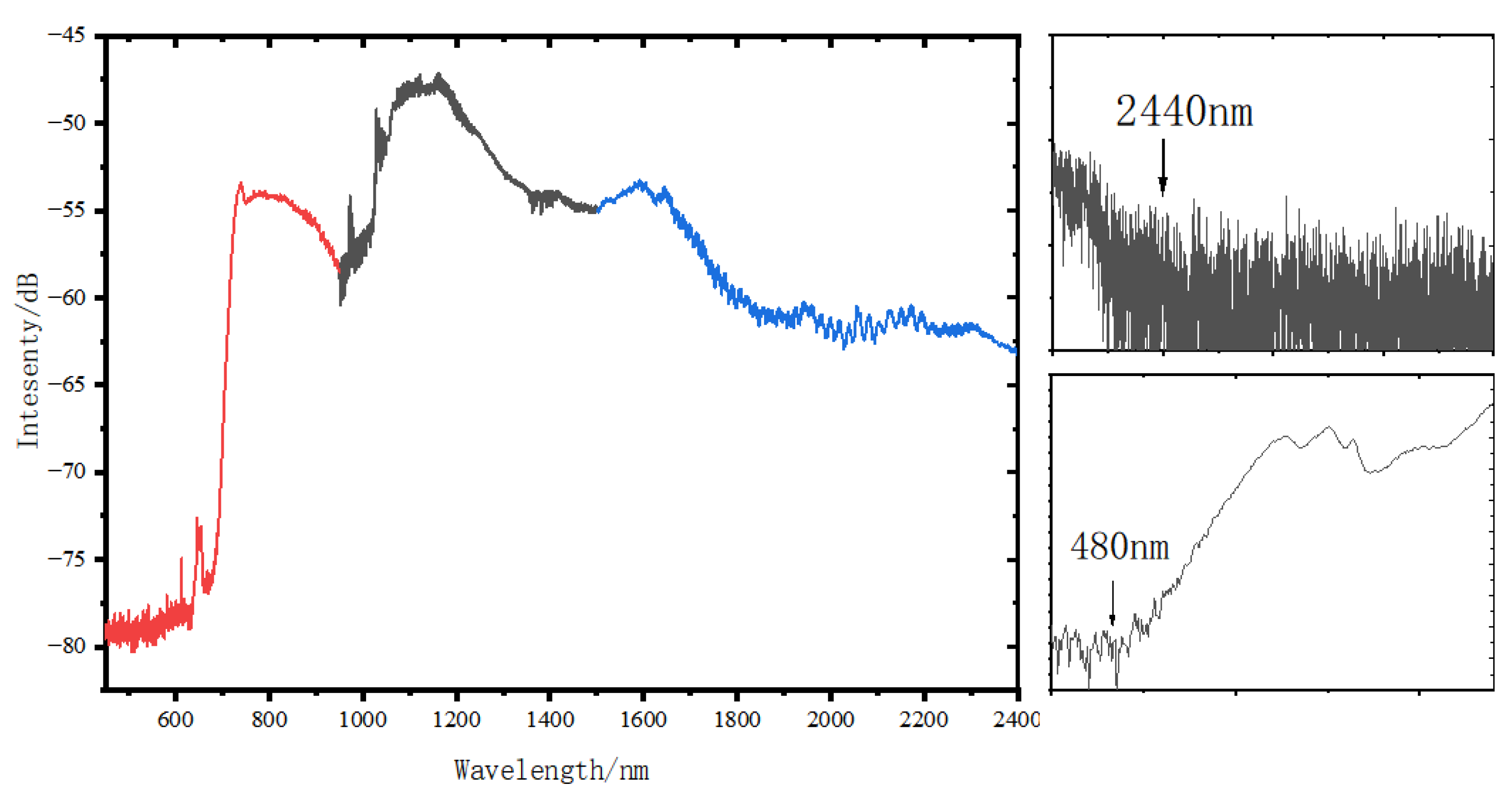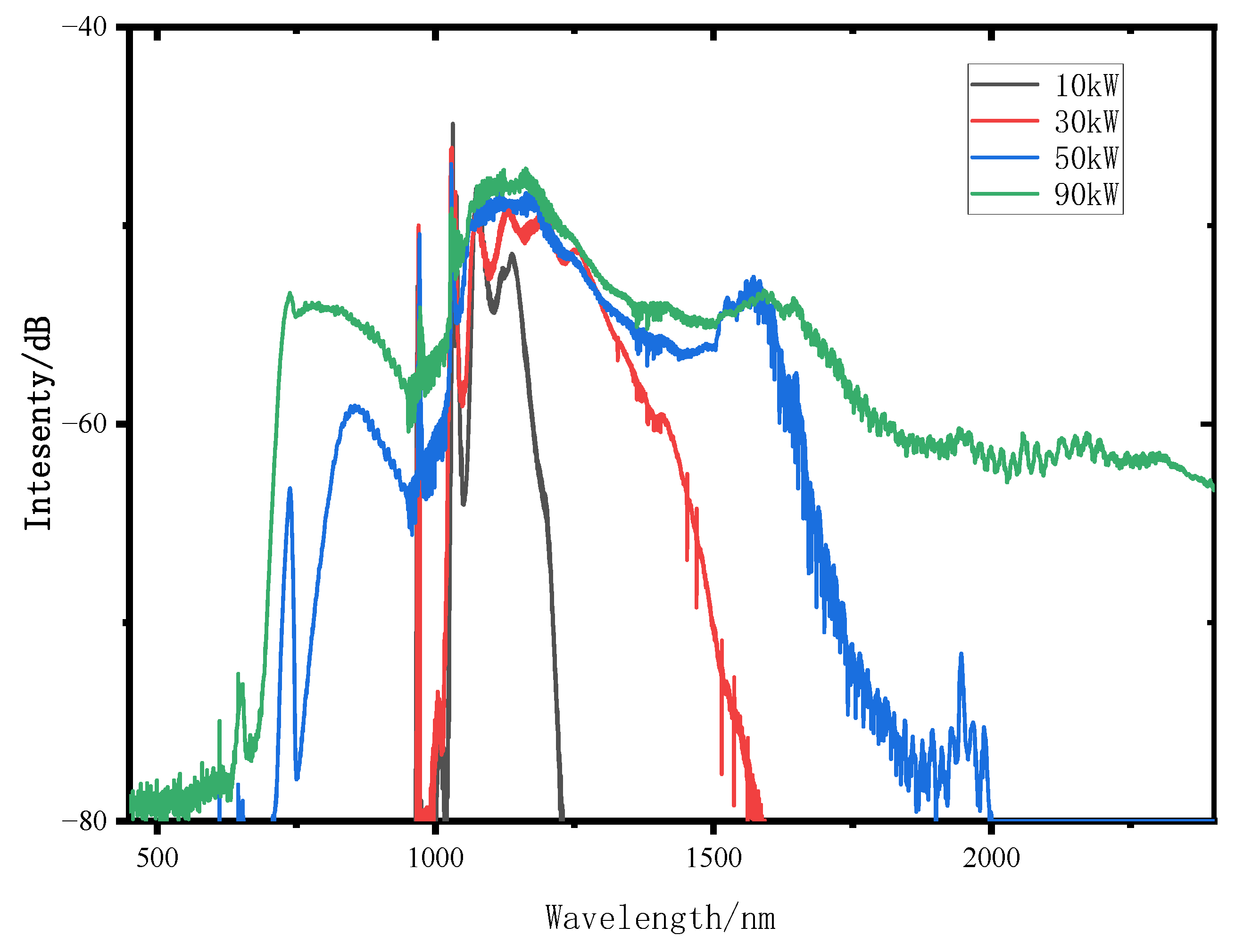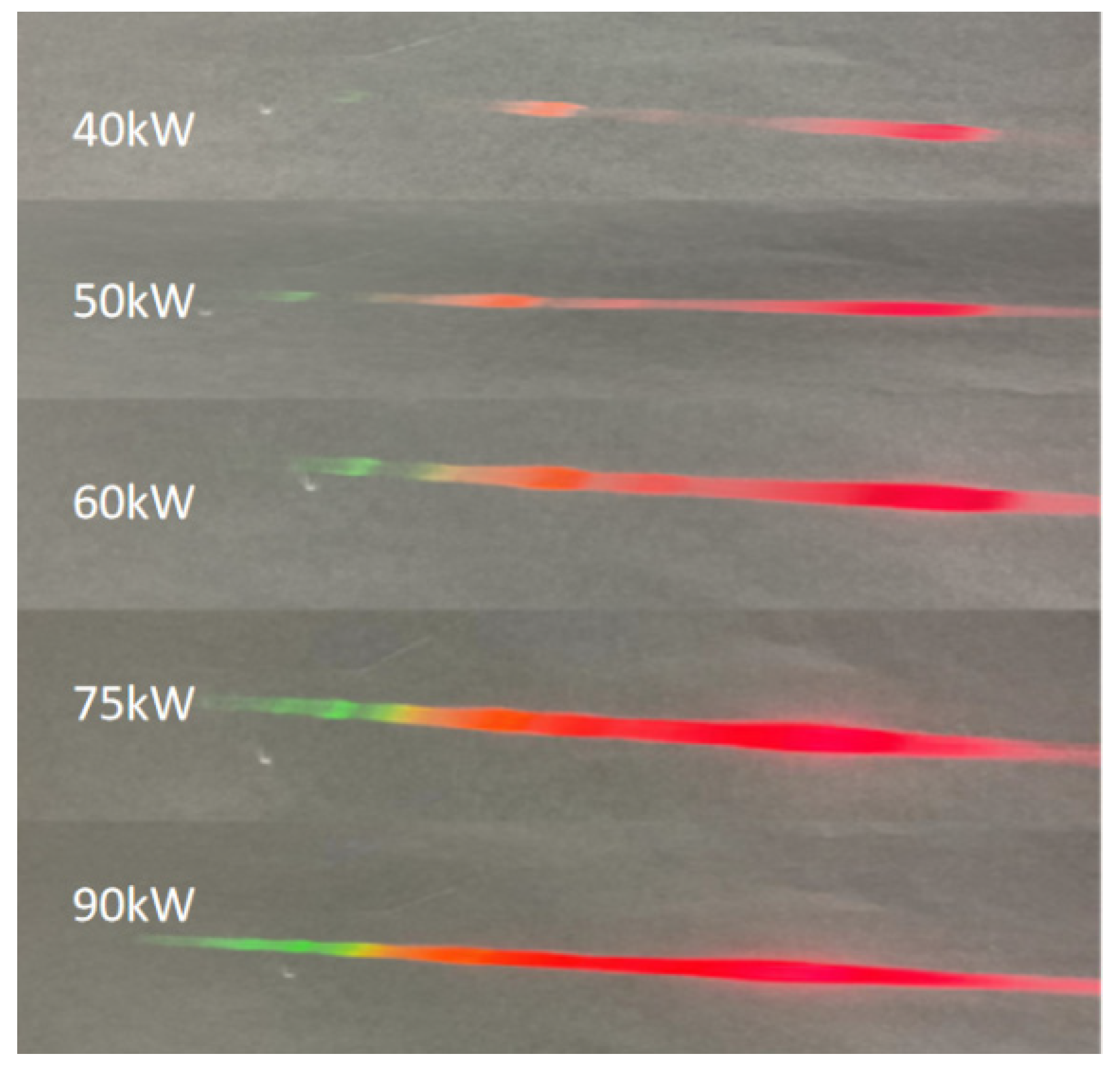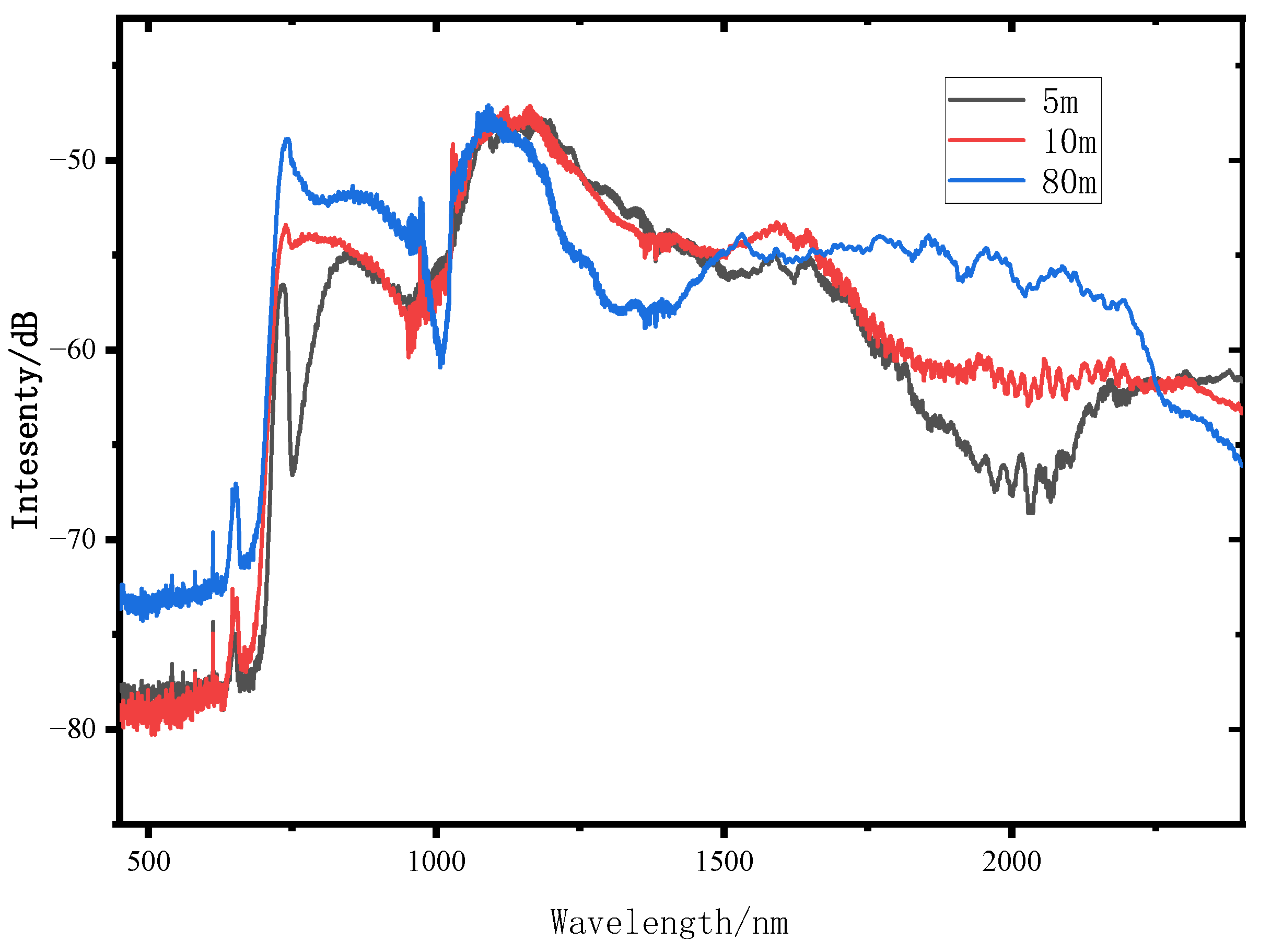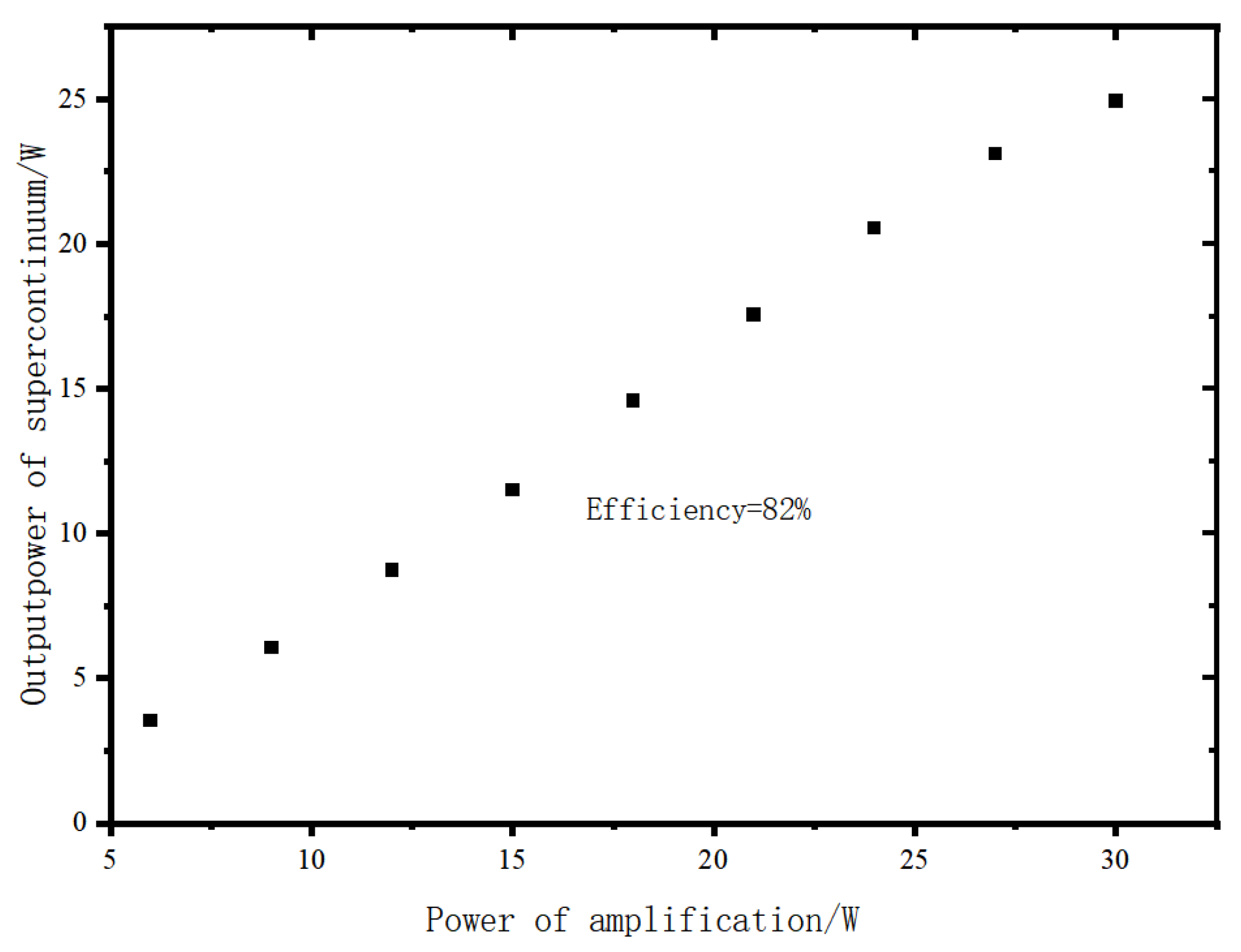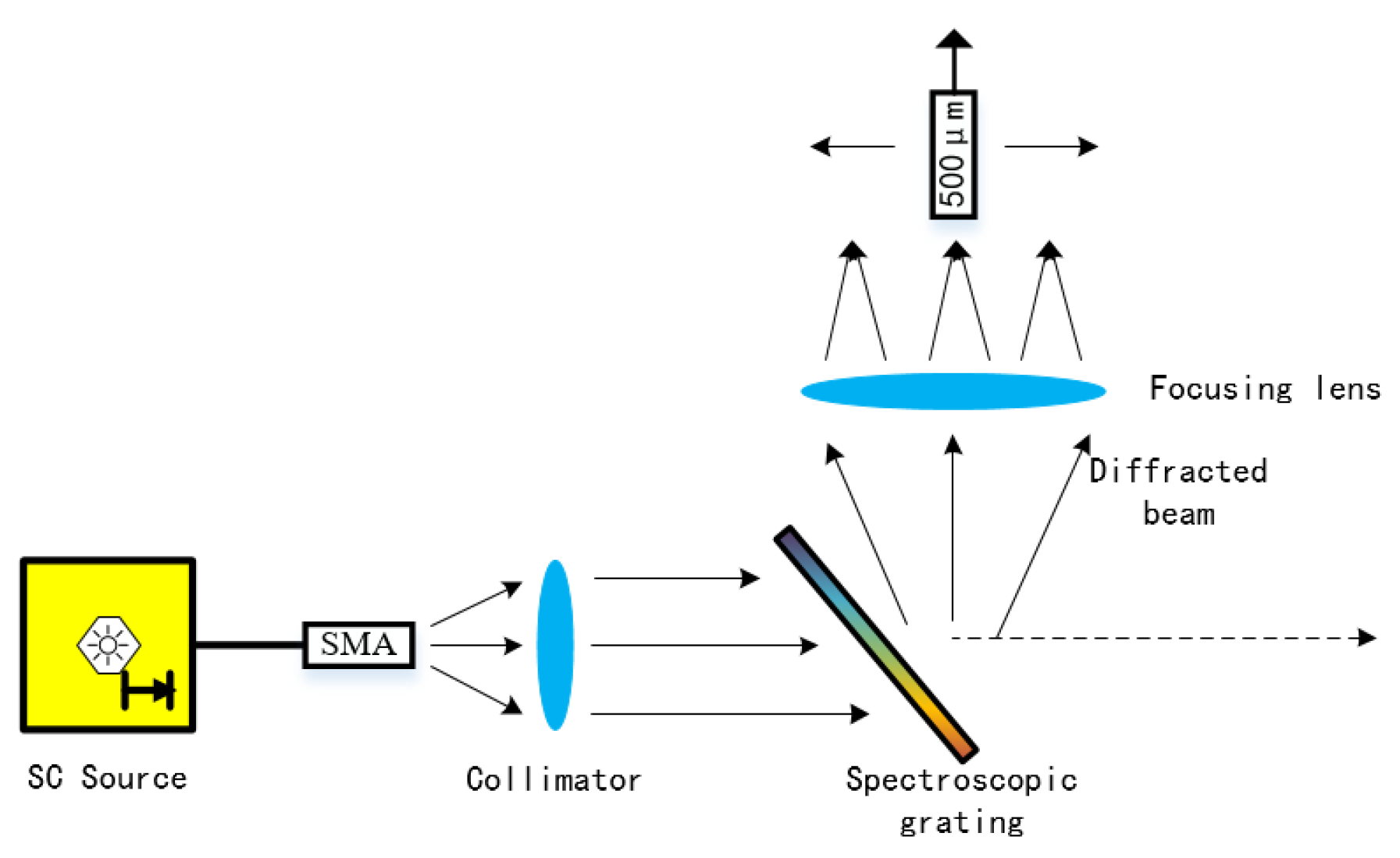1. Introduction
The supercontinuum has gained tremendous progress in the last few decades. Supercontinuum sources are widely used in optical coherence tomography (OCT) [
1] and biomedicine [
2]. The rapid development of photonic crystal fibers (PCF) has attracted more research on supercontinuum [
3,
4]. The dynamic of nonlinearity effects based on the generation of supercontinuum by picosecond and femtosecond lasers have been well explained [
5]. The average power of PCF-based generation of supercontinuum has been reported to be higher than 200 W [
6], however, the small core diameters of PCFs make it difficult to further increase its average power [
7]. The splicing of photonic crystal fibers with other fibers is also a challenge, which usually requires a mode field adaptor to match the different cores [
8]. The conversion efficiency of the supercontinuum is also challenging to exceed 50% [
9]. Meanwhile water cooling at the splicing point of the PCF is required. Due to these issues, the core diameter of the gain fiber in the amplifier does not exceed 20 µm before the photonic crystal to ensure efficiency, limiting the peak power of amplification.
In recent years, the unique nonlinear dynamics in the grade-index (GRIN) multimode fibers has gained scientists’ attention. Research on the generation of supercontinuum based on GRIN fiber geometric parametric instability has been reported [
10]. In addition, the quasi-phase matched intermodal four-wave mixing (FWM) [
11] and Kerr self-cleaning (KSC) [
12] observed in GRIN fibers are also interesting. Compared to single-mode or few-mode fibers, GRIN multimode fibers offer greater advantages in high-power applications. G. Lopez-Galmiche et al. demonstrated ultra-broad supercontinuum generation (450–2400 nm) using a GRIN multimode optical fiber pumped in the normal dispersion regime at 1064 nm with an amplified Q-switched micro-chip laser [
10]. Uğur Teğin et. al. reported that a supercontinuum with an output power of 3.96 W was achieved in a GRIN MMF with 62.5 µm core diameter using picosecond pulses at MHz repetition rate [
13]. There are also some reports on the generation of supercontinuum in GRIN fibers [
14,
15]. However, current studies on the generation of supercontinuum spectra based on GRIN fibers were all performed at lower average powers (below 5 W).
In this paper, we report an all-fiber supercontinuum source with an average power of 25 W and a repetition frequency of 8.27 MHz. The spectrum width of the supercontinuum covered 480 nm to 2440 nm. The all-fiber structure was achieved by directly splicing the GRIN fiber with the pigtail of the picosecond laser. The variation of the supercontinuum spectrum was studied by varying the input powers and the length of the GRIN fiber. Self-cleaning of the beam in the GRIN fiber was observed. The GRIN fiber can be pumped at high peak powers and does not require water cooling. The conversion efficiency from the injected laser pulse to the supercontinuum is about 82% higher than the other schemes generating supercontinuum based on GRIN fibers. To the best of our knowledge, this is the highest average power reported to date for supercontinuum generation based on a GRIN fiber.
2. Experiment Setup
The structure diagram of the all-fiber supercontinuum source is shown in
Figure 1. The seed source is a homemade all-normal-dispersion nonlinear amplification loop mirror mode-locked fiber oscillator with a central wavelength of 1030 nm. The output pulse has a repetition rate of 8.27 MHz, a pulse width of 23 ps, and a spectral width of 25 nm. The broad spectrum and narrow pulse width of this mode-locked oscillator facilitate the broadening and flattening of the supercontinuum. The average power of the oscillator is 200 mW. Our previous work has demonstrated that this oscillator can be compressed to less than 200 fs after amplification in a Yb-doped amplification system [
16]. The amplifier adopts a three-stage cascade. The length of the gain fibers in the three amplifiers is 0.5 m (PM-HI-6/125-YSF), 1 m (PM-10/130-YDF), and 1.3 m (PM-30/250-YDF), respectively. The fiber length is strictly controlled to avoid nonlinear effects. The parameters of the components are summarized in
Table 1.
The output pigtail size of the last stage amplifier is 30/250 μm, which does not match the cladding and core diameter of the GRIN fiber, while the core diameter of 30/250 μm Yb-doped fiber is less than that of the GRIN fiber. The numerical aperture of the 30/250 μm Yb-doped fiber is 0.07, while the numerical aperture of the GRIN fiber is 0.195. Therefore, the output laser of the amplifier can enter the GRIN fiber completely by directlu splicing the GRIN fiber with the Yb-doped fiber under suitable splicing conditions. The lengths of the GRIN fiber were chosen as 5 m, 10 m, and 80 m. The GRIN fiber is the 50/125 μm multimode fiber (Corning, ClearCurve OM4). The 105/125 μm standard multimode fiber was spliced to GRIN fiber as the end cap and cleaved 8° angle to reduce return light. The splicing point of GRIN fiber can operate stably at room temperature for a long time without water cooling.
3. Results and Discussion
The spectral evolution of the signal light from the oscillator to passing through the picosecond amplifier is shown in
Figure 2a. The spectral width of the seed was reduced from the initial 25 nm to 18 nm after the three amplifiers, which was mainly due to the gain narrowing effect. The output power of the last amplifier stage and the pump power is shown in
Figure 2b. We obtained a picosecond pulse with the maximum average output power of about 30 W. The amplification slope efficiency was 75% at the beginning. At the last amplification, there was nonlinear amplification with slight stimulated Raman scattering effect when the output power was higher than 27.5 W, which led to a decrease in the amplification efficiency. The amplified pulse width increased to 34 ps at 27.5 W average output power, corresponding to a pulse peak power of about 90 kW.
The spectrum of the supercontinuum was detected by three optical spectrum analyzers (OSAs) covering the spectral range from 200 to 950 nm (Maya 2000 Pro, Dunedin, FL, USA), 950 to 1500 nm (YOKOGAWA AQ6370D, Tokyo, Japan), and 1500 to 2400 nm (YOKOGAWA AQ6375, Tokyo, Japan), respectively.
Figure 3 shows the spectrum of the supercontinuum after the 10 m GRIN fiber. Compared to the signal light, the spectrum in the GRIN fiber shows a significant broadening, both in the long and short wavebands. The supercontinuum extended from 480 nm to 2440 nm. The spectrum showed good flatness in the 1000 nm range centered on the signal light wavelength. Due to the broad spectrum of the signal light, a flatter evolution of the supercontinuum was promoted.
The generated supercontinuum in the 10 m GRIN fiber with different input powers is presented in
Figure 4. When injected by the low peak power pump pulses, the spectral broadening was mainly caused by stimulated Raman scattering effect. Several intense Stokes peaks can be observed in the spectrum. Broad spectral emerges when the SRS extended to the zero-dispersion wavelength (~1310 nm) of the fiber. As the input power increased, the generation of shorter wavelengths begun to appear. The generation of visible wavelengths was mainly caused by the generation of dispersion waves [
17]. At the same time, four-wave mixing effect further contributed to the intensity and flatness of the visible spectrum. At the peak pump power of 90 kW, long and short waveband spectra were significantly enhanced. The increase of the peak power promoted spectral broadening and flatness enhancement.
Figure 5 shows the evolution of the visible part of the supercontinuum (obtained by transmission grating spectroscopy) when the peak power of the pulses was increased. At a peak power of roughly 40 kW, the visible light was observed in the observation screen after the spectroscopy, and initially appeared as distinct peaks near green 530 nm, yellow 650 nm, and red 730 nm. Subsequently, with these peaks as centers, the brightness increased, the spectrum continuity rose, and finally, at the peak power of 90 kW, a continuously visible spectrum was formed.
Figure 6 shows supercontinuum obtained at different lengths of 5 m, 10 m, and 80 m of the GRIN fiber. The 80 m GRIN fiber generated the flattest spectrum, and the 5 m GRIN fiber generated the worst flatness of the spectrum. As the fiber length increased, the spectral intensity rose in the visible waveband and long waveband beyond 1500 nm. Although the supercontinuum generated by the 5 m GRIN fiber showed an increase in the spectral intensity above 2000 nm in the spectrogram, this was due to the high-order diffraction of laser near 1 μm in the spectrometer. This part of the spectrum should be ignored so that the range of spectrum was the shortest in the long waveband with a fiber length of 5 m. For the fiber length of 10 m and 80 m, the high laser intensity around 2000 nm can mask the effect of the high-order diffraction. Due to the characteristics of silicon-based fibers, in which the optical loss at wavelengths above 2200 nm was significant, the decreasing trend of the last segment of the spectrum with 80 m fiber length was more noticeable than the 10 m fiber length. The longer fiber also promoted the conversion in the visible waveband, and the intensity of the visible waveband is higher. The experimental results showed that the longer fiber length improved the flatness and spectral extension of the supercontinuum.
The output power of the supercontinuum decreased with the increasing length of GRIN fiber. The maximum output supercontinuum average power was about 24.9 W, 22.3 W, and 15.2 W at the fiber length of 5 m, 10 m, and 80 m, respectively. This was mainly due to the high absorption loss of graded-index fiber for some wavelengths. While ensuring a high-quality supercontinuum output, the GRIN fiber length should be controlled to avoid power degradation.
Figure 7 shows the efficiency curves of the pump power and supercontinuum power at the GRIN fiber length of 5 m. The overall conversion efficiency of the supercontinuum was about 82%, which was higher than that with photonic crystal fiber (about 50%), demonstrating the effectiveness of direct splicing of a GRIN fiber with the gain fiber. Continuous operation at the highest power for 4 h is realized, and the power instability is less than 1.8% with the spectrum and beam quality remaining basically unchanged.
Figure 8 shows the evolution of the output beam profile (1030 nm) from the GRIN fiber during the increase of pumping power. At low peak powers, the spot showed a poor beam quality. During the increase of the peak power of the pump pulse from 10 kW to 90 kW, it was clearly observed that the beam profile tends to be Gaussian. The M
2 at the wavelength of 1030 nm was measured from 5.1 to 2.5 at the output power of 6 kW to 90 kW. Near-field beam profiles with wavelengths of 580, 760, 850, and 1030 nm were measured and shown in
Figure 9. It can be seen that all beam distributions tend to be Gaussian-like at different wavelengths, although GRIN fiber supported multiple modes. The similar clean-up process was also observed for far-fields beam profiles (not shown here). This clean-up process was similar to the phenomenon observed by Krupa K et al. [
12]. Kerr self-cleaning (KSC) is caused by the coupling among the fundamental mode and high-order modes and could wash out the linear mode mixing and attain a cleaned self-sustained beam.
A simple spectroscopic device was devised to help obtain different wavelengths of light. As shown in
Figure 10, the light from the supercontinuum source was emitted to the transmission grating through the collimating mirror. The diffracted light from the transmission grating was focused onto the focal plane by a focusing lens. An optical fiber with a core diameter of 500 µm was placed on the focal plane to receive light at different wavelengths. This fiber can be moved on the focal plane to change the wavelength of light received, and the core diameter of the fiber can be changed to change the spectral width. With this simple spectroscopic device, the light of any wavelength in the supercontinuum can be obtained.

